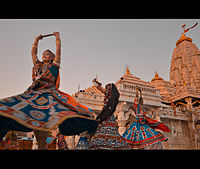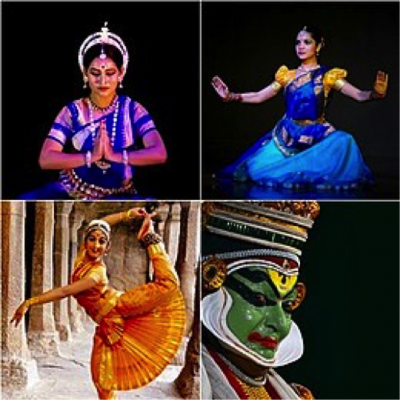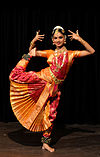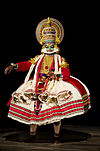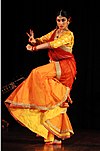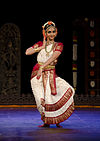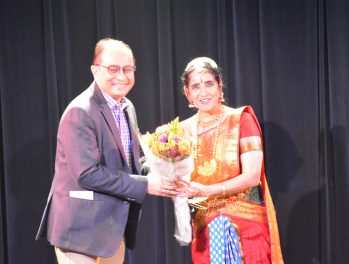Source: Wikipedia
Dance in India comprises numerous styles of dances, generally classified as classical or folk. As with other aspects of Indian culture, different forms of dances originated in different parts of India, developed according to the local traditions, and also imbibed elements from other parts of the country.
Sangeet Natya Academy, the national academy for performing arts in India, recognizes eight traditional dances as Indian classical dances, while other sources and scholars recognize more. These have roots in the Sanskrit text Natya Shastra, and the religious performance arts of Hinduism.
Folk dances are numerous in number and style and vary according to the local tradition of the respective state, ethnic or geographic regions. Contemporary dances include refined and experimental fusions of classical, folk and Western forms.
Dancing traditions of India have influence not only over the dances in the whole of South Asia, but also on the dancing forms of South East Asia as well. Dances in Indian films like Bollywood Dance for Hindi films, are often noted for freeform expression of dance and hold a significant presence in the popular culture of the Indian subcontinent
Nomenclature
A classical dance is one whose these theory, culture. training, means and rationale for expressive practice is documented and Pragathi traceable to ancient classical texts, particularly the Natya Shastra. Classical Indian dances have historically involved a school or guru-shishya parampara (teacher-disciple tradition) and require studies of the classical texts, physical exercises and extensive training to systematically synchronize the dance repertoire with underlying play or composition, vocalists and the orchestra.
A folk Indian dance is one which is largely an oral tradition, whose traditions have been historically learnt and mostly passed down from one generation to the next through word of mouth and casual joint practice. A semi-classical Indian dance is one that contains a classical imprint but has become a folk dance and lost its texts or schools. A tribal dance is a more local form of folk dance, typically found in one tribal population; typically tribal dances evolve into folk dances over a historic period.
Origin of Dance in India
The origins of dance in India go back into the ancient times. The earliest Paleolithic and Neolithic cave paintings such as the UNESCO world heritage site at Bhimbetka rock shelters in Madhya Pradesh shows dance scenes. Several sculptures found at Indus Valley Civilization archaeological sites, now distributed between Pakistan and India, show dance figures. For example, the Dancing Girl sculpture is dated to about 2500 BCE, shows a 10.5 centimeters (4.1 in) high figurine in a dance pose.
The Vedas integrate rituals with performance arts, such as a dramatic play, where not only praises to gods were recited or sung, but the dialogues were part of a dramatic representation and discussion of spiritual themes. The Sanskrit verses in chapter 13.2 of Shatapatha Brahmana (≈800–700 BCE), for example, are written in the form of a play between two actors.
The Vedic sacrifice (yajna) is presented as a kind of fight, with its actors, its dialogues, and its portion to be set to music, its interludes, and its climaxes. — Louis Renou, Vedic India
The evidence of earliest dance related texts are in Natasutras, which are mentioned in the text of Panini, the sage who wrote the classic on Sanskrit grammar, and who is dated to about 500 BCE.
This performance arts-related Sutra text is mentioned in other late Vedic texts, as are two scholars names Shilalin and Krishashva (Kṛśaśva), credited to be pioneers in the studies of ancient drama, singing, dance and Sanskrit compositions for these arts. Richmond et al. estimate the Natasutras to have been composed around 600 BCE, whose complete manuscript has not survived into the modern age.
The classic text of dance and performance arts that has survived is the Hindu text Natya Shastra, attributed to sage Bharata. He credits the art his text systematically presents to times before him, ultimately to Brahma who created Natya-veda by taking the word from the Rigveda, melody from the Samaveda, mime from the Yajurveda, and emotion from the Atharvaveda. The first complete compilation of Natya Shastra is dated to between 200 BCE and 200 CE, but estimates vary between 500 BCE and 500 CE. The most studied version of the Natya Shastra text consists of about 6000 verses structured into 36 chapters. The classical dances are rooted in Natya Shastra
India has a number of classical Indian dance forms, each of which can be traced to different parts of the country. Classical and folk dance forms also emerged from Indian traditions, epics and mythology.
Classical dance of India has developed a type of dance-drama that is a form of a total theater. The dancer acts out a story almost exclusively through gestures. Most of the classical dances of India enact stories from Hindu mythology. Each form represents the culture and ethos of a particular region or a group of people.
The criteria for being considered as classical is the style’s adherence to the guidelines laid down in Natyashastra, which explains the Indian art of acting. The Sangeet Natak Akademi currently confers classical status on eight Indian classical dance styles: Bharatanatyam (Tamil Nadu), Kathak (North, West and parts of Central India), Kathakali (Kerala), Kuchipudi (Andhra Pradesh) Odissi (Odisha), Manipuri (Manipur), Mohiniyattam (Kerala), and Sattriya (Assam). All classical dances of India have roots in Hindu arts and religious practices.
The tradition of dance has been codified in the Natyashastra and a performance is considered accomplished if it manages to evoke a rasa (emotion) among the audience by invoking a particular bhava (gesture or facial expression). Classical dance is distinguished from folk dance because it has been regulated by the rules of the Natyashastra and all classical dances are performed only in accordance with them.
Dating back to 1000 BC, Bharatanatyam is a classical dance from the South Indian state of Tamil Nadu, practiced predominantly in modern times by women. The dance is usually accompanied by classical Carnatic music. Bharatnatyam is a major genre of Indian classical dance that originated in the Hindu temples of Tamil Nadu and neighboring states and regions.
Traditionally, Bharatanatyam has been a solo dance that was performed exclusively by women, and expressed Hindu religious themes and spiritual ideas, particularly of Shaivism, but also of Vaishnavism and Shaktism.
Bharatanatyam and other classical dances in India were ridiculed and suppressed during the colonial British Raj era. In the post-colonial period, it has grown to become the most popular classical Indian dance style in India and abroad, and is considered to be synonymous with Indian dance by many foreigners unaware of the diversity of dances and performance arts in Indian culture.
Kathakali (katha, ‘story’; kali, ‘performance’) is a highly stylized classical dance–drama form which originated from Kerala in the 17th century. This classical dance form is another ‘story play’ genre of art, but one distinguished by its elaborately colorful make-up, costumes and face masks wearing actor-dancers, who have traditionally been all males.
Kathakali primarily developed as a Hindu performance art, performing plays and mythical legends related to Hinduism. While its origin are more recent, its roots are in temple and folk arts such as Kutiyattam and religious drama traceable to at least the 1st millennium CE.
A Kathakali performance incorporates movements from the ancient martial arts and athletic traditions of south India. While linked to the temple dancing traditions such as Krishnanattam, Kutiyattam and others, Kathakali is different from these because unlike the older arts where the dancer-actor also had to be the vocal artist, Kathakali separated these roles allowing the dancer-actor to excel in and focus on choreography while the vocal artists focused on delivering their lines.
Kathak is traditionally attributed to the traveling bards of ancient northern India, known as Kathakars or the storytellers. The term Kathak is derived from the Vedic Sanskrit word katha meaning “story”, and kathaka in Sanskrit means “he who tells a story”, or “to do with stories”.
Kathak evolved during the Bhakti movement, particularly by incorporating childhood and amorous stories of Hindu god Krishna, as well as independently in the courts of north Indian kingdoms. It transitioned, adapted and integrated the tastes and Persian arts influence in the Mughal courts of the 16th and 17th century, was ridiculed and declined in the colonial British era, then was reborn as India gained independence.
Kathak is found in three distinct forms, named after the cities where the Kathak dance tradition evolved–Jaipur, Benares and Lucknow. Stylistically, the Kathak dance form emphasizes rhythmic foot movements, adorned with small bells (Ghungroo), the movement harmonized to the music, the legs and torso are generally straight, and the story is told through a developed vocabulary based on the gestures of arms and upper body movement, facial expressions, stage movements, bends and turns.
Kuchipudi classical dance originated in a village of Krishna district in modern era Indian state of Andhra Pradesh. It has roots in antiquity and developed as a religious art linked to traveling bards, temples and spiritual beliefs, like all major classical dances of India.[69][70][71] In its history, the Kuchipudi dancers were all males, typically Brahmins, who would play the roles of men and women in the story after dressing appropriately.
Modern Kuchipudi tradition believes that Tirtha Narayana Yati and his disciple, an orphan named Siddhendra Yogi founded and systematized the art in the 17th century. Kuchipudi largely developed as a Hindu god Krishna-oriented Vaishnavism tradition, and it is most closely related to the Bhagavata Mela performance art found in Tamil Nadu, which itself has originated from Andhra Pradesh. The Kuchipudi performance includes pure dance (nritta), and expressive part of the performance (nritya), where rhythmic gestures as a sign language mime the play.Vocalists and musicians accompany the artist, and the tala and raga set to Carnatic music. In modern productions, Kuchipudi dancers include men and women
Odissi originated in the Hindu temples of Odisha – an eastern coastal state of India. Odissi, in its history, was performed predominantly by women, and expressed religious stories and spiritual ideas, particularly of Vaishnavism (relating to the god Vishnu as Jagannath), but also of other traditions such as those related to Hindu gods Shiva and Surya, as well as Hindu goddesses (Shaktism).
Odissi is traditionally a dance-drama genre of performance art, where the artist(s) and musicians play out a mythical story, a spiritual message or devotional poem from the Hindu texts, using symbolic costumes, body movement, abhinaya (expressions) and mudras (gestures and sign language) set out in ancient Sanskrit literature
Sattriya is a classical dance-drama performance art with origins in the Krishna-centered Vaishnavism monasteries of Assam, and attributed to the 15th century Bhakti movement scholar and saint named Srimanta Sankarde One-act plays of Sattriya are called Ankiya Nat, which combine the aesthetic and the religious through a ballad, dance and drama. The plays are usually performed in the dance community halls (namghar) of monastery temples (sattras). The themes played relate to Krishna and Radha, sometimes other Vishnu avatars such as Rama and Sita.
Manipuri, is also known as Jagoi and is named after the region of its origin – Manipur, a state in northeastern India bordering with Myanmar (Burma). This dance is particularly known for its Hindu Vaishnavism themes, and performances of the love-inspired dance drama of Radha-Krishna called Rass Lila. However, the dance is also performed under themes related to Shaivism, Shaktism and regional deities such as Umang Lai during Lai Haraoba.
The Manipuri dance is a team performance, with its own unique costumes notably the Kumil (a barrel shaped, elegantly decorated skirt), aesthetics, conventions and repertoire. The Manipuri dance drama is, for most part, marked by a performance that is graceful, fluid, and sinuous, with greater emphasis on hand and upper body gestures.
Mohiniyattam developed in the state of Kerala, gets its name from Mohini – the seductress avatar of Vishnu, who in Hindu mythology uses her charms to help the good prevail in a battle between good and evil. Mohiniyattam follows the Lasya style described in Natya Shastra, that is a dance which is delicate, with soft movements and feminine. It is traditionally a solo dance performed by women after extensive training. The repertoire of Mohiniyattam includes pure and expressive dance-drama performance, timed to sopana (slower melody) styled music, with recitation. The songs are typically in a Malayalam-Sanskrit hybrid form called Manipravala.
Folk dances and plays in India retain significance in rural areas as the expression of the daily work and rituals of village communities.
Sanskrit literature of medieval times describes several forms of group dances such as Hallisaka, Rasaka, DandRasaka and Charchari. The Natya Shastra includes group dances of women as a preliminary dance performed in prelude to a drama.
India has numerous folk dances. Almost every state in India has its own folk dance. These are some examples we name: Bihu and Bagurumba in Assam, Garba, Gagari, Ghodakhund and Dandiya in the state of Gujarat, Nati in the state of Himachal Pradesh, Neyopa, Bacha Nagma in Jammu and Kashmir, Jhumair, Domkach in Jharkhand, Bedara Vesha, Dollu and Kunitha in the state of Karnataka, Thirayattam and Theyyam in Kerala, Dalkhai in Western Odisha, Bhangra and Giddha in Punjab, Kalbelia, Ghoomar, and Rasiya in Rajasthan, Perini in Telangana, Chholiya in Uttarakhand. Lavani, Lezim, and Koli are the most popular dances in Maharashtra. Likewise for each state and smaller regions, there are various dances.
Tribal dances in India are inspired by the tribal folklore. Each ethnic group has its own distinct combination of myths, legends, tales, proverbs, riddles, ballads, folk songs, folk dance, and folk music.
The dancers do not necessarily fall rigidly into the category of “tribal”. However, these forms of dance closely depict their life, social relationships, work and religious affiliations. They represent the rich culture and customs of their native lands through intricate movements of their bodies. A wide variation can be observed in the intensity of these dances. Some involve very slight movement with a more groovy edge to it, while others involve elevated and vigorous involvement of limbs.
These dances are composed mostly on locally made instruments. Percussion instruments feature in most of these dances. Music is produced through indigenous instruments. Music too has its own diversity in these tribal dances with the aesthetics ranging from mild and soothing to strong and weighted rhythms.
A few of them also have songs, either sung by themselves or by onlookers. The costumes vary from traditional saris of a particular pattern to skirts and blouses with mirror work for women and corresponding dhotis and upper-wear for men. They celebrate contemporary events, victories and are often performed as a mode of appeasing the tribal deities.
A lot of the dance styles depend upon the regional positioning of the ethnic group. Factors as small as east or west of a river result in a change of dance form even though the over-reaching look of it may seem the same. The religious affiliation affects the content of the songs and hence the actions in a dance sequence. Another major factor affecting their content are the festivals, mostly harvest.
For example, the ethnic groups from the plain land rabhas from the hilly forested areas of Assam make use of baroyat (plate-like instrument), handa (a type of sword), boushi (adze-like instrument), boumshi (bamboo flute), sum (heavy wooden instrument), dhansi. kalbansi, kalhurang, chingbakak. Traditionally, their dances are called basili. Through their dance, they express their labors, rejoicing and sorrow. The Handur Basu pseudo-war dance expresses strength and solidarity.

